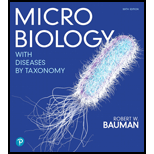
(1)
To determine:
The reason as to why patients who take antacids are at greater risk for infections withVibrio vulnificus.
Introduction:
Vibrio vulnificus is a Gram-negative vibrio shaped bacterium. This bacterium is found in marine environments, such as coastal areas, brackish ponds, or estuaries. Vibrio vulnificus is known to cause food poisoning to people and it is commonly ingested by eating raw tainted oysters.
(2)
To determine:
Whether antacids raise or lower the
Introduction:
Vibrio vulnificus is a Gram-negative vibrio shaped bacterium. This bacterium is found in marine environments, such as coastal areas, brackish ponds, or estuaries. Vibrio vulnificus is known to cause food poisoning to people and it is commonly ingested by eating raw tainted oysters.
(3)
To determine:
How people can reduce the risk of infection besides refraining from antacids.
Introduction:
Vibrio vulnificus is a Gram-negative vibrio shaped bacterium. This bacterium is found in marine environments, such as coastal areas, brackish ponds, or estuaries. Vibrio vulnificus is known to cause food poisoning to people and it is commonly ingested by eating raw tainted oysters.
Want to see the full answer?
Check out a sample textbook solution
Chapter 2 Solutions
EBK MICROBIOLOGY WITH DISEASES BY TAXON
- In one paragraph show how atoms and they're structure are related to the structure of dna and proteins. Talk about what atoms are. what they're made of, why chemical bonding is important to DNA?arrow_forwardWhat are the structure and properties of atoms and chemical bonds (especially how they relate to DNA and proteins).arrow_forwardThe Sentinel Cell: Nature’s Answer to Cancer?arrow_forward
- Molecular Biology Question You are working to characterize a novel protein in mice. Analysis shows that high levels of the primary transcript that codes for this protein are found in tissue from the brain, muscle, liver, and pancreas. However, an antibody that recognizes the C-terminal portion of the protein indicates that the protein is present in brain, muscle, and liver, but not in the pancreas. What is the most likely explanation for this result?arrow_forwardMolecular Biology Explain/discuss how “slow stop” and “quick/fast stop” mutants wereused to identify different protein involved in DNA replication in E. coli.arrow_forwardMolecular Biology Question A gene that codes for a protein was removed from a eukaryotic cell and inserted into a prokaryotic cell. Although the gene was successfully transcribed and translated, it produced a different protein than it produced in the eukaryotic cell. What is the most likely explanation?arrow_forward
- Molecular Biology LIST three characteristics of origins of replicationarrow_forwardMolecular Biology Question Please help. Thank you For E coli DNA polymerase III, give the structure and function of the b-clamp sub-complex. Describe how the structure of this sub-complex is important for it’s function.arrow_forwardMolecular Biology LIST three characteristics of DNA Polymerasesarrow_forward
 Human Heredity: Principles and Issues (MindTap Co...BiologyISBN:9781305251052Author:Michael CummingsPublisher:Cengage LearningEssentials of Pharmacology for Health ProfessionsNursingISBN:9781305441620Author:WOODROWPublisher:Cengage
Human Heredity: Principles and Issues (MindTap Co...BiologyISBN:9781305251052Author:Michael CummingsPublisher:Cengage LearningEssentials of Pharmacology for Health ProfessionsNursingISBN:9781305441620Author:WOODROWPublisher:Cengage Biology 2eBiologyISBN:9781947172517Author:Matthew Douglas, Jung Choi, Mary Ann ClarkPublisher:OpenStax
Biology 2eBiologyISBN:9781947172517Author:Matthew Douglas, Jung Choi, Mary Ann ClarkPublisher:OpenStax





